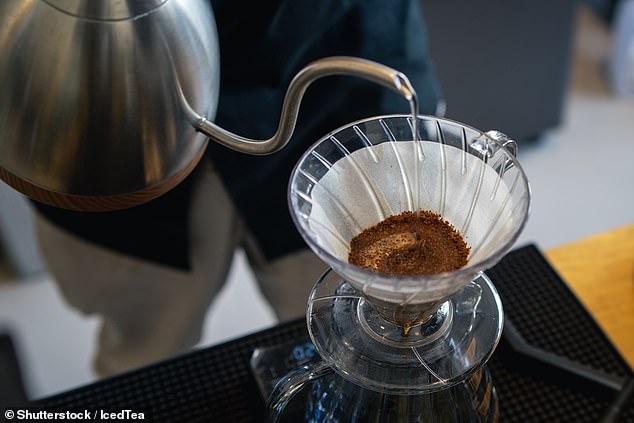Some people are really, really particular about how their coffee is made.
And although it might be an old-fashioned way to do it, some aficionados still make their cup using the pour-over method.
This involves pouring hot water over ground coffee beans, which then passes through filter paper into a carafe.
Now, experts have found the best way to pour the water to make a stronger drink.
By experimenting with different variables, they found that pouring water from a great height using a gooseneck kettle creates the strongest flavour.
‘What we recommend is making the pour height as high as possible, while still maintaining a laminar flow, where the jet doesn’t break up when it impacts the coffee grinds,’ said author Ernest Park, from the University of Pennsylvania.
In particular, the group found the thick water jets typical of standard gooseneck kettles are ideal for achieving this necessary height and a streamlined flow.
Strong — but focused — water jets create an avalanche in the coffee grounds, they said.

Using a gooseneck kettle, like the one pictured here, helps create a streamlined flow of water, the experts said

Stages showing what happens to the coffee grounds when water is poured from a height, starting with erosion, mixing and then an ‘avalanche’
The grounds recirculate as the water digs deeper into the coffee bed, allowing for better mixing between the water and the grounds, they said.
This results in a stronger coffee with fewer beans.
If the water jet is too thin, it cannot adequately create this interaction to achieve a desirable strength and sensory experience.
‘If you have a thin jet, then it tends to break up into droplets,’ said co-author Margot Young.
‘That’s what you want to avoid in these pour-overs, because that means the jet cannot mix the coffee grounds effectively.’
The scientists used laser-illuminated transparent particles in a glass funnel as part of their study, to help them visualise the mixing dynamics and understand how the liquid jets affects the grounds.
They suggest people do ‘try this at home’ to further refine the technique as there are other parameters left to explore – including the size of the coffee grounds.
‘We can really learn something from both the chemistry and physics points of view by looking at the kitchen,’ they said.
‘It leads to new science where you didn’t expect it.’

Pouring from a height creates an ‘avalanche’ in the coffee grounds, allowing for better mixing and a stronger flavour
While they did not examine it in this study, coffee experts recommend using a medium-coarse grind size and a brewing time of around three minutes.
They recommend rinsing the filter paper with hot water first, to get rid of any ‘papery’ taste.
High-quality spring water boiled in a kettle produces the best results, while a hotter temperature will give a lighter roast and a cooler temperature will produce a darker roast.
The findings were published in the journal Physics of Fluids.
A recent survey revealed that the UK is the world’s instant coffee capital, with most Brits choosing convenience over a more cultivated cup.
A whopping 54 percent of us opt for the quick, dehydrated form of the hot drink instead of filter, cafetière or pod coffee, a study found.
This compares to just 39 percent of coffee drinkers outside the UK, according to a global report by professional services network Deloitte.
More Brits take their coffee with low-fat milk than their overseas counterparts – 40 percent versus 22 percent.
This article was originally published by a www.dailymail.co.uk . Read the Original article here. .

